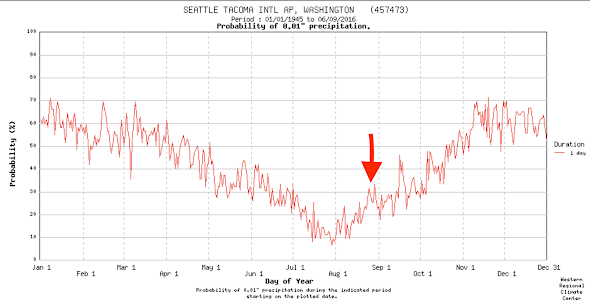The meteorology of a region does not necessarily follow the calendar, and that is certainly true for the Northwest.
Calendar autumn--starting at the fall or autumnal equinox-- begins on September 23.
But meteorological autumn in the Northwest generally starts the last week of August, with increasing precipitation and declining temperatures.
And this year will be no exception.
The satellite image this morning shows clouds and showers over the Northwest and developing weather systems offshore...with our name on it!
Showers and thunderstorms have moved through the region during the past several hours, as shown by 6:30 AM weather radar composite below. Particularly heavy showers over northeast Washington.
To gain some insight into our regional climatology, check out this graph of the climatological probability of receiving at least 0.01 inch of precipitation in a day at SeaTac Airport (with an arrow indicating today). On average there is a huge increase in precipitation probability between the last days of July (around 8%) to today (about 30%)
Major atmospheric circulation changes have already started, with an increasing north-south temperature difference and the acceleration of the jet stream.
The latest high-resolution prediction of precipitation accumulation over our region through Friday at 5 PM (starting 5 AM this morning) is shown below. Much of the region, except the lower Columbia Basin, will get a good wetting, with particularly heavy amounts in the north Cascades and the Oregon Cascades, as well as the northern Rockies.
Well placed to knock down some of the current wildfires.
The prediction of precipitation total for the subsequent 72 h shows continued precipitation west of the Cascade crest.
Temperatures will be far cooler than we have dealt with during the past months, as illustrated by the extended forecasts at Seattle and Pasco (from the National Weather Service National Blend of Models). In Seattle, highs only around 70F Wednesday and Thursday, a brief warm spell from Friday through Sunday (reaching 81F), and back to around 70F the following week.
Pasco in the Tri-Cities only warms to the mid-80s.
The extended range 6-10 day forecast from the NOAA Climate Prediction Center shows cooler than normal and wetter than normal conditions expected.
This change in weather takes place at a critical time since we are now in the period when western Washington and Oregon are traditionally vulnerable to westside fires driven by strong easterly winds.
But not this year.
Finally, there is a definitive indication of when a major cool-down will is occurring, one supported by the experts in the City of Seattle:
_________________________________________
I am teaching Atmospheric Science 101 this fall in hybrid mode.
You can attend in person or online.
I should note that Washington State residents over 60 can take it for a very small charge (like $25) through the ACCESS program.
And I would certainly welcome any UW undergraduate or graduate students.












Looking at the radar from 1pm on 8/29 has a very interesting line of storms streaming from the Tacoma area on west side of Sound that runs north of Victoria and into the Straits of Georgia. The line of storms seems to keep the San Juan's in the bullseye since yesterday. Any insight why that's acting that way? Is it a stalled cold front? Or north south oriented convergence zone?
ReplyDeleteSuper curious about this as well, the radar has been wild to watch - I'd say we've got significantly more precipitation in the last 2hrs in Chimacum than predicted for the next 84hrs at least
DeleteThe thunder has been non-stop in Port Townsend today.
DeleteSorry I missed it.
DeleteOne thing I notice is that even short term, the location of the rain is often not well predicted. Tuesday night, Fox 13 predicted heavy rain in the central sound today (Thursday) at midday. Today it seems that prediction is no longer valid.
DeleteI grew up in this region, and have been here over 65 years. Historically, we always assumed Autumn began on Labor Day weekend. Rain always started on your first day off work that weekend. I've found it generally reliable to have dry season July 5 to Labor Day
ReplyDeleteA perfectly fitting start to the season today. Here's to hoping for continued damp and chilly weather to clear out the smoke and tamp down fires, at least for a little while. Saying that, it's nice to see a warm and sunny day peaking out from the clouds on Saturday, too.
ReplyDeleteYour course looks interesting, but it looks like you have to be a UW student to register. Anyway for those living in Canada to register or audit the online version?
ReplyDeleteModels I think over did it a bit for Okanogan Valley. Storms kept weakening before reaching us and when the low closed it didn't spin up much. Omak airport recorded a trace from time to time. My guage read just a tenth this morning. Air is fresh and cool though, feels like fall. However, other places got hammered. Wanted to be storm chaser yesterday and see how heavy the rain was in some of those cells. Just watch in envy on radar from my desk. Kept looking at NAM hires and HRRR thinking we will get our turn like they showed. I jinxed it by turning off my water.
ReplyDeleteOne way to understand this change in late August is to focus on its relative distance from summer’s peak, the Summer Solstice. In late August we’re as far from late June as is mid-April. There are additional meteorological phenomenon that affect changes in the atmosphere, and the temperature, but the angle of the sun, and the energy we receive, is declining. Not many think of April as summery weather, not in the NW.
ReplyDeleteThe leaves are definitely starting to change color in Whatcom County.
ReplyDelete